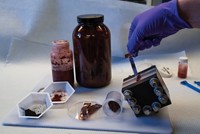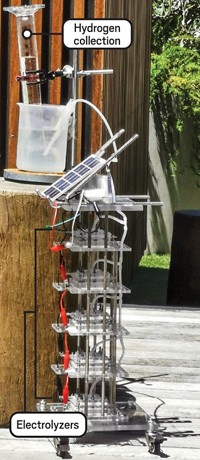Advertisement
Grab your lab coat. Let's get started
Welcome!
Welcome!
Create an account below to get 6 C&EN articles per month, receive newsletters and more - all free.
It seems this is your first time logging in online. Please enter the following information to continue.
As an ACS member you automatically get access to this site. All we need is few more details to create your reading experience.
Not you? Sign in with a different account.
Not you? Sign in with a different account.
ERROR 1
ERROR 1
ERROR 2
ERROR 2
ERROR 2
ERROR 2
ERROR 2
Password and Confirm password must match.
If you have an ACS member number, please enter it here so we can link this account to your membership. (optional)
ERROR 2
ACS values your privacy. By submitting your information, you are gaining access to C&EN and subscribing to our weekly newsletter. We use the information you provide to make your reading experience better, and we will never sell your data to third party members.
Catalysis
Chemists demonstrate a practical, green route to H2O2
Solid-state electrolyte enables an electrochemical synthesis with a small carbon footprint
by Leigh Krietsch Boerner
October 11, 2019
| A version of this story appeared in
Volume 97, Issue 40

Hydrogen peroxide can do a lot of things, like bleach hair, whiten teeth, and disinfect drinking water. The way chemists make H2O2 takes a lot of energy and relies on fossil fuel feedstocks, giving it a large carbon footprint. The compound is also unstable, so chemical makers must add stabilizers to move and store the chemical—and those stabilizers then need to be removed before use.
Now, Haotian Wang and coworkers from Rice University have developed an electrochemical synthesis of H2O2 that uses less energy and could produce the H2O2 where it is needed, without requiring the cumbersome stabilizers (Science 2019, DOI: 10.1126/science.aay1844). This cleaner method can use a solid-state electrolyte, water, and air, without fossil fuels.
Generally, industry makes H2O2 via a multistep process that involves anthraquinone and generates a lot of organic waste. Electrochemical syntheses of H2O2 exist but often rely on reactors that use liquid electrolytes. The H2O2 gets produced in the electrolyte, so chemists have to separate it from the liquid before use.
As an alternative, Wang and fellow researchers used commercially available solid-state materials with micropores where the reaction occurs. They then flush the reactor with deionized water, which allows the team to make H2O2 solutions of any concentration up to 20% by weight, says Chuan Xia, a postdoc in Wang’s lab. “This is high enough for use as a disinfectant.”
The team performed the reduction and oxidation steps in separate parts of the reactor, to minimize the safety hazard of mixing high-pressure H2 and O2. Both gases independently first diffuse through catalysts—an iridium oxide catalyst produces H+ from H2, and an oxidized carbon catalyst produces HO2– from O2. The intermediates then pass through ion exchange membranes before reaching the solid-state electrode, which is made from either functionalized styrene-divinylbenzene copolymer microspheres or a cesium-tungsten oxide, and react with each other to produce H2O2.
The researchers propose that their reactor could be installed where needed, such as in hospitals, eliminating the need to transport H2O2. Since chemical manufacturers have to dilute the chemical for transport, shipping H2O2 is the largest part of its carbon footprint. Xia says that if the reactor is powered by solar panels and H2O is used as an alternate source of H2, no fossil fuels would be needed in the process.
This work demonstrates that chemists can use electrochemical synthesis to make chemicals, fuels, and medicine more practically, says Yang Shao-Horn, a materials chemist at the Massachusetts Institute of Technology.





Join the conversation
Contact the reporter
Submit a Letter to the Editor for publication
Engage with us on Twitter